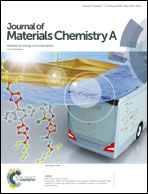Identification of cathode stability in Li–CO2 batteries with Cu nanoparticles highly dispersed on N-doped graphene†
Abstract
Rechargeable Li–CO2 batteries are promising energy storage systems for reducing fossil fuel consumption and mitigating the “greenhouse effect” due to the reversible reaction between lithium ions and carbon dioxide. The addition of metal nanoparticles with high catalytic activities can accelerate the reaction between Li2CO3 and carbon during the charge process, but more work is required to accurately describe how metal nanoparticles work in Li–CO2 batteries. In this study, a gel-like film synthesis mechanism method is presented for the preparation of a composite of Cu nanoparticles that are highly dispersed on N-doped graphene (Cu-NG), which acts as an efficient cathode for Li–CO2 batteries. Additionally, Cu-NG can achieve a low overpotential of 0.77 V and has excellent cyclability (50 cycles). It is speculated that superoxide radicals generated from the self-decomposition of Li2CO3 unavoidably corrode electrodes during the charge process. Nevertheless, the surface of the Cu nanoparticles forms a 3–5 nm thick CuO film that protects and stabilizes the cathode during later cycles. This study may open up new directions and strategies for developing highly efficient cathodes and provide a better understanding of the electrochemical processes of Li–CO2 batteries.



 Please wait while we load your content...
Please wait while we load your content...